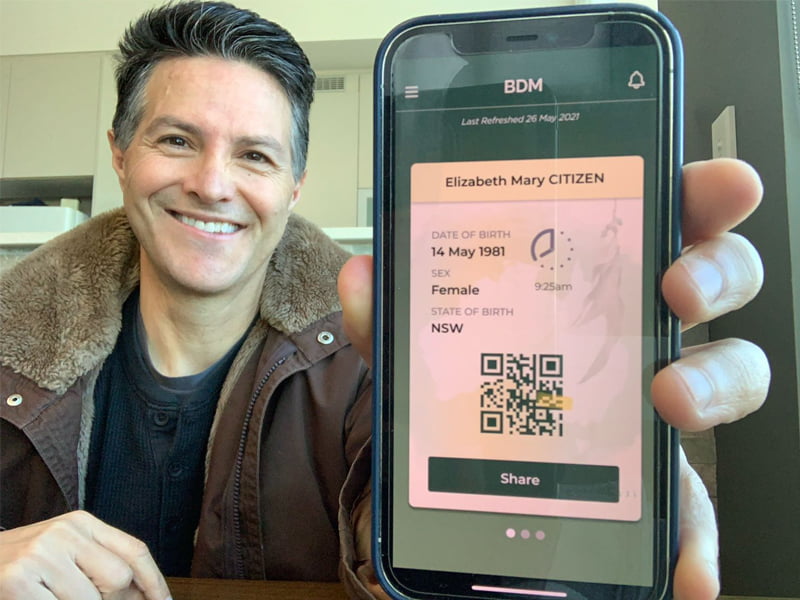The NSW government is exploring whether it can integrate federal COVID-19 immunisation records into its Service NSW app.
The potential integration comes as it also moves ahead with its plan to have a digital birth certificate prototype ready by the end of the year.
Once NSW begins to open up after lockdown, it’s expected some types of venues will require patrons to provide proof of vaccination in addition to checking in via a QR code, on top of requiring ID if they’re an establishment like a nightclub. This type of experience is already required in some countries overseas that have begun opening up.

“That is a very clunky experience to essentially open three different apps just to get through the front door,” NSW Customer Service and Digital Minister Victor Dominello told InnovationAus.
He said he was hoping to “work with the federal government” to provide people choice.
“That is, if they want to have it [vaccination records] on their Service NSW app, they can. If they don’t, they don’t have to.”
He has also suggested that such a record in the Service NSW app could detail whether someone was fully or partially vaccinated against COVID-19.
Meanwhile, the minister said digitising birth certificates would be “critical” to digital identity as his department works on creating one.
“We hope to have a [digital birth certificate] prototype out in the market before the end of the year,” he said.
“And if we bed that down, we then unlock a lot of problems around, for example, cybersecurity.”
It would be important that NSW gets digital identity right, he said, because “we can build a lot of resilience and help people out in the event that there’s been a breach”.
The way the digital certificate was being designed at present would mean entities who receive it would receive less information than they do now.
“When you provide people with your birth certificate right now, it contains a whole load of information that quite frankly they don’t need,” the minister siad.
With the digital version, all citizens would need to do is show their digital birth certificate and a QR code and if proof is required for record-keeping purposes, recipients would get a generated log number that proves that a person has validated their certificate with them.
This would mean that third parties don’t actually store original birth certificates, which the minister said was another way of protecting digital identities.
On another front, Mr Dominello remained optimistic that NSW’s own services would one day act as a portal into federal government services and vice versa.
“We’re working with the federal government on that,” he said. “So I’ll be guided by them [on a timeframe].
“We’re ready, willing and able. But obviously, it’s a much more complicated task for them because they just don’t have NSW to deal with; they’ve got all the other states and territories as well.
“I have high regard for Minister [Stuart] Robert [in charge of digital at a federal level]. And I remember discussing with him where we both agreed there should be no wrong door to government.
“People don’t care whether it’s state, federal, local. They just want better service delivery.”
Best known as being the minister on a mission to get rid of paper, often sharing his ideas on LinkedIn for feedback, Mr Dominello has been on a roll of late in digitising his state.
“If you love paper, do origami,” he said, adding: “I love paper in that form, but I think paper is just an almost criminal waste when it’s used to guide process.”
He said one of the silver linings of the pandemic was that there had been an “enormous growth” in digital maturity and understanding in the last eighteen months.
“Eighteen months ago, I was banging the drum and trying to sell the case and trying to say how important [digital] is not just for economic efficiency but for customer experience.
“Now people understand that; there are not as many roadblocks now.”
Speaking on why his department recently decided to roll out physical QR codes for checking in, he said it was because of feedback received from the community about those without smartphones.
“There was a lot of feedback that … there is still a cohort of our society that either don’t have smartphones or have old smartphones that can’t even read QR cards,” he said.
“So I thought, listening to the concerns of the community, and the feedback we were receiving, there must be a better way.”
On LinkedIn, he said he apologised for not including everyone in his original thinking of the QR code check-in rollout.
“Whilst the check-in card is good – it also illuminates a personal blind spot,” he wrote. “In my desire to hasten the digital journey – I did not properly reflect on the inclusion piece. I apologise for this.”
Do you know more? Contact James Riley via Email.

